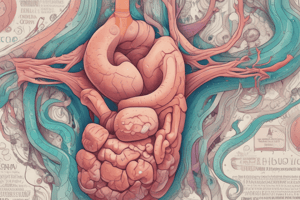Podcast
Questions and Answers
What are common signs and symptoms of intestinal obstruction?
What are common signs and symptoms of intestinal obstruction?
- Abdominal fullness, constipation, vomiting, inability to pass gas and stool (correct)
- Back pain, joint stiffness, coughing, sore throat
- Abdominal pain, diarrhea, excessive burping, fever
- Abdominal distension, frequent urination, chest pain, dizziness
What is a key nursing intervention for a patient with intestinal obstruction?
What is a key nursing intervention for a patient with intestinal obstruction?
- Provide extra blankets for comfort
- Administer high-dose painkillers
- Monitor fluid and electrolyte levels (correct)
- Encourage frequent ambulation
How can nausea and vomiting be managed in a patient with intestinal obstruction?
How can nausea and vomiting be managed in a patient with intestinal obstruction?
- Provide strong-smelling foods to distract from nausea
- Encourage the patient to eat large meals to reduce nausea
- Relieve nausea and vomiting through NG suctioning out the contents of the stomach (correct)
- Limit fluid intake to reduce vomiting
Flashcards
Intestinal obstruction symptoms
Intestinal obstruction symptoms
Abdominal fullness, constipation, vomiting, inability to pass gas or stool
Nursing care for intestinal obstruction
Nursing care for intestinal obstruction
Monitoring fluid and electrolyte levels is critical.
Nausea/Vomiting management
Nausea/Vomiting management
Use NG suction to relieve nausea and vomiting.
Study Notes
Intestinal Obstruction: Signs and Symptoms
- Abdominal pain or tenderness, often localized to the obstructed area
- Nausea and vomiting, potentially with bile or feces
- Abdominal distension or bloating
- Constipation or inability to pass stool or gas
- Presence of bowel sounds or abdominal bruits
- Fever, potentially with signs of peritonitis
Nursing Interventions for Intestinal Obstruction
- Monitoring for signs of dehydration, such as decreased urine output or dark urine
- Administering IV fluids and electrolyte replacement to prevent dehydration
- Withholding oral intake to reduce nausea and vomiting
- Maintaining NPO (nothing by mouth) status to prevent further obstruction
Managing Nausea and Vomiting
- Administering anti-emetic medications to reduce nausea and vomiting
- Providing small, frequent sips of water or clear fluids to help manage dehydration
- Positioning the patient in a side-lying or upright position to reduce aspiration risk
- Using nasogastric suction to relieve nausea and vomiting, as ordered by a physician
Studying That Suits You
Use AI to generate personalized quizzes and flashcards to suit your learning preferences.
Description
Test your knowledge of intestinal obstruction and the corresponding nursing interventions with this quiz. Learn about the signs, symptoms, and vital nursing care for patients with this condition.





